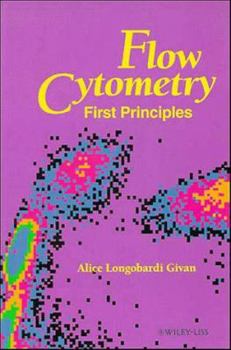Flow Cytometry: First Principles
Select Format
Select Condition 
Book Overview
Flow Cytometry First Principles Alice Longobardi Givan Geared for the nonspecialist, Flow Cytometry: First Principles presents a succinct, accessible "user friendly" approach to exploring flow cytometry and its relevance to modern biology and biomedicine. Starting with the fundamentals of instrumentation, data analysis, and interpretation of experimental and diagnostic results, the author provides a tutorial treatment of applications both in the laboratory and the clinic that will appeal to the novice and expert alike. Using concrete examples to illustrate general concepts, this self-teaching guide builds the reader's technical understanding of the capabilities and limitations of modern analytical cytology. Students, research faculty, clinical specialists, and laboratory technologists will gain an appreciation of the range of experimental procedures and diagnostic measurements that are possible with today's flow cytometric instrumentation. An outgrowth of years of lecture and laboratory workshop instruction by the author, Flow Cytometry: First Principles is designed for the needs of those in cell and molecular biology, immunology, oncology, hematology, laboratory medicine, and other areas that rely upon the quantitative measurement and selective purification of cells and their constituents. This practical introduction will prove indispensable for the nonspecialist who wishes to understand the power and the pitfalls of this technology -- toward a more critical interpretation of the literature as well as the effective design and implementation of laboratory protocols.
Format:Paperback
Language:English
ISBN:0471560952
ISBN13:9780471560951
Release Date:August 1992
Publisher:Wiley
Length:216 Pages
Weight:0.90 lbs.
Dimensions:9.0" x 0.5" x 6.0"
Customer Reviews
4 ratings
Good for beginner.
Published by Thriftbooks.com User , 16 years ago
Good for beginners/non-speicialists who want to know general principles in flow cytometry. It's easy to read and understand.
It's a nice book!
Published by Thriftbooks.com User , 17 years ago
The book includes almost you need to know before starting flow cytometry. If anyone wants to broadly get the knowledge but not go into the detail of flow cytometry, it's a good choice. You probably can go through it in 1-2 days.
An Expert's Opinion
Published by Thriftbooks.com User , 24 years ago
"I consider it to be the best presentation of principles of flow cytometry. The text is clearly written, the figures are well chosen." -- Zbigniew Darzynkiewicz, Brander Cancer Research Institute, New York Medical College
a necessary primer in flow-cytometry
Published by Thriftbooks.com User , 28 years ago
A core book designed mainly for the nonspecialist, "Flow Cytometry: First Principles" is addressing in ten chapters the essential issues in flow-cytometry, from flow machines to reagents, techniques and their applications in fundamental research and clinical settings. The first chapters conveys us as back as the beginning of the century, when the concept of flow-cytometry germinated. Light microscopy, cell counters and ink jet technology are standing at the grounds of flow-cytometry and their merging paved the way toward the modern, "black box", flow cytometers. However, "beyond the black box", the instrumentation and the technical aspects are comprehensively described in several chapters. a discussion on data acquisition and analysis is provided, along with the most used cell staining procedures, fluorochromes, lenses, mirrors and lasers. A widespread application in flow-cytometry is cell labelling, particularly leukocyte subpopulations identification with monoclonal antibodies binding cell surface specific markers. Although lymphocytes are the prototype, methods presented here -dot-plot, histogram, quadrant analysis and gating are applicable to many other cell types , including bacteria or algae. With the advent of some "state of the art" machines, DNA and chromosome analyses become feasible by flow-cytometry. It is foreseeable that molecular biology on flow-cytometer will not stop to cell cycle, ploidy and apoptosis investigation, but even chromosomal translocations or point mutations would be detectable with enough precision for diagnosis. Beside fundamental research applications, flow-cytometry is now an indispensable technique in the clinical laboratory, too. Oncology, immunology, hematology and pathology are fields where flow diagnosis has sometimes the last word to say. Cross-match analysis and HLA phenotyping can now rapidly be performed by flow-cytometry, with usefulness in organ and bone-marrow transplantation. The final chapter is intended to present the flow-cytometry of the future, as seen in 1992, with an emphasis on the functional assays which are gaining now an increasing interest. However, a precedent, "out of the stream" chapter is preparing us on what this future could look alike. It approaches some of the border-line pplications, in fields where flow-cytometry is becoming a current tool of research. These are microbiology -prokaryotic DNA and drug resistance determination-, ecology -aquatic environment, plankton, algae-, developmental biology or the functional studies -Ca2+influx. The book is highly recommended for flow-cytometry and sorting beginners, but it is an equally pleasant lecture for people working in many life sciences fields, eager to find out how flow-cytometry is shaping current biological research.






